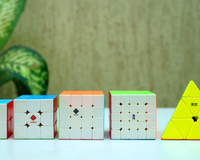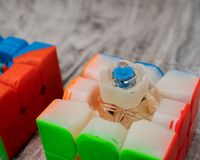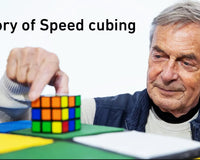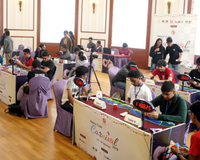Introduction
When it comes to speedcubing, mastering finger tricks is one of the most important factors to improve your solving time. Finger tricks minimize hand movement, allowing you to execute your solves smoothly and quickly. In this guide, we’ll cover the fundamentals to developing the best finger tricks.
Why Finger Tricks Matter?
Many beginners rely on wrist turns, which are slow and inefficient. Finger tricks enable faster execution by keeping hand movement to a minimum. For example, the common "R U R' U'" sequence can be done much faster with proper finger tricks rather than full-hand turns. It is important to learn and refine good finger tricks in the earlier part of your cubing journey, as it becomes difficult to break bad finger trick habits once they are set.
Home Grip

Good finger tricks begin with the correct home grip ie. the way you naturally hold the cube.
- Hold your left thumb firm on the front center
- Right thumb on the front-right edge
- Right index, right middle and right ring fingers on the back-right side of the cube.
- Left index, left middle and left ring fingers on the back-left side of the cube.
- Both pinky fingers loosely on the underside of the cube, providing stability.
Essential Finger Tricks for Beginners
If you're new to finger tricks, start with these foundational moves:
1. U and U' Moves

- U (Clockwise): Flick the top layer with your right index finger.
- U' (Counterclockwise): Use your left index finger to push the top layer back.
2. R and L Moves tip (primarily for F2L)

- R: Start in home grip and use your right wrist to turn the R face. Important: Do not change your grip from home grip before doing the R move. This is because during F2L, it is almost guaranteed that an R move is later followed by an R’, making regrips for the first R move obsolete.
- L: slide your thumbs over slightly and use your left wrist to turn the left face.
3. F and F' Moves

- F (Clockwise): Reposition your hands to use your right index finger to flick the front face, similar to the U finger trick.
- F' (Counterclockwise): Use your right thumb to push it back.
4. D and D' Moves

- D (Clockwise): Flick the bottom layer using your left ring finger.
- D' (Counterclockwise): Use your right ring finger.
Advanced Finger Tricks
- Once you have mastered the basics, refining your finger tricks will give you an extra edge.
1. Double Flicks (UU and UU')
Instead of doing two separate U moves, use a double flick:
- Use your right index and middle fingers to flick the top layer twice quickly for U2.
- For U2', use your left index and middle fingers.
Double flicks can also be used for F2, D2 and B2 moves.
2. Pinch F’

- Use your left index finger to do F’ while keeping your left thumb on the front center.
3. Pinch R U R’

- Start in the home grip
- After the first R, pinch the back right corner with your right thumb and index and push it to the front.
- Finish with R’. You should be back in home grip in this position.
4. M and M' Moves

M moves are crucial in algorithms like H and Z perms.
- M (Middle Layer Down): Use your left or right ring finger to push the middle layer down.
- M' (Middle Layer Up): Use your left or right ring finger to flick it up.
- M2: Double flick using any one of your ring fingers followed by your middle finger of the same hand.
Common Mistakes and How to Fix Them
1. Overusing Wrist Turns
New cubers tend to rely on wrist movements instead of finger flicks. This slows down execution and makes transitions between moves inefficient. Fix: Consciously use your fingers instead of your whole wrist to turn the cube.
2. Poor Finger Positioning
If your fingers are not positioned correctly, you'll struggle to perform fluid finger tricks. Fix: Keep your hands relaxed and try to stay in home grip throughout the solve.
3. Not Practicing Algorithm Execution
If you only practice solving and not finger trick execution separately, your improvement will be slower. Fix: Drill common algorithm sequences and build your speed.
4. Unnecessary Regrips
If you find yourself constantly shifting your grip between moves, you're losing time. A prime example of this is constantly regripping just for R and L moves. Fix: Do untimed solves where you focus on getting rid of this habit by doing these moves from home grip, and gradually incorporate the same in timed solves.
Training Your Finger Tricks
To get the most out of your finger tricks, here are some targeted exercises:
- Algorithm Drills: Take a set of algorithms like PLL or OLL and execute them repeatedly at high speeds.
- Slow Solving: Solve the cube slowly while paying attention to efficiency in finger movement.
- One-Handed Solving: Practicing OH solves can help develop dexterity in your fingers.
Conclusion
Finger tricks are a fundamental skill that can make or break your solves. Whether you're pushing for sub-20, sub-10, or even sub-8, refining your finger tricks is an essential step in your cubing journey. Start practicing these techniques today, and you'll see noticeable improvements in your speed and fluency.
Happy Cubing!
































